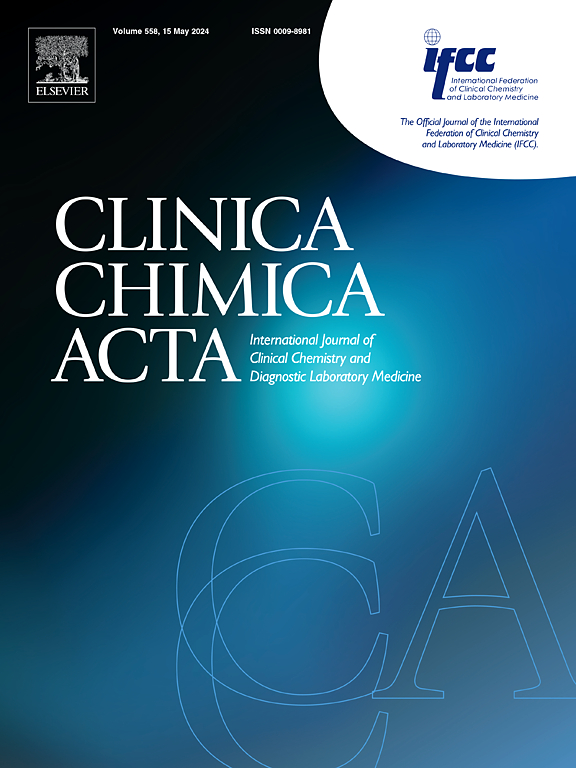Redefining vitamin D status: Establishing population-based indirect reference intervals through big data analysis
IF 3.2
3区 医学
Q2 MEDICAL LABORATORY TECHNOLOGY
引用次数: 0
Abstract
Objectives
To establish accurate population-based reference intervals (RIs) for serum 25-hydroxyvitamin D [25(OH)D] using the refineR indirect method and real-world data (RWD), accounting for demographic, methodological, and seasonal factors.
Methods
A retrospective analysis of 130,030 serum 25(OH)D samples collected from 2018 to 2022 at a tertiary hospital in Barcelona was performed. Samples were measured using VDSP-certified Liaison and Atellica immunoassays. The refineR algorithm was employed to establish RIs, utilizing Box-Cox transformations to adjust for data distribution. Demographic variables (sex and age), assay differences, medical department and seasonal variations were analysed. RIs were verified using a subset of healthy individuals.
Results
The median serum 25(OH)D level was 25 ng/mL (62.5 nmol/L). Vitamin D deficiency (≤20 ng/mL, ≤50 nmol/L) was observed in 34.2% of samples, and severe deficiency (≤12 ng/mL, ≤30 nmol/L) in 12.6%. The default Box-Cox transformation estimated RIs of 11.5–64.5 ng/mL (28.7-161.2 nmol/L), while the modified Box-Cox transformation yielded RIs of 14.2–65.9 ng/mL (35.5-164.7 nmol/L). Women exhibited wider RIs (14.5–68.6 ng/mL, 36.2-171.5 nmol/L) compared to men (11.6–57.3 ng/mL, 29-143.2 nmol/L). Method-specific RIs were 10.2–58.6 ng/mL (25.5-146.5 nmol/L) for the Liaison assay and 9.9–59.3 ng/mL (24.7-133.2 nmol/L) for the Atellica assay. The lowest RIs were observed in outpatients (4.3–46.4 ng/mL, 10.7-116 nmol/L) and endocrinology patients (5.5–43.9 ng/mL, 13.7-109.7 nmol/L). Seasonal variation significantly impacted RIs, with higher levels during summer months.
Conclusions
The refineR algorithm effectively established population-based RIs for serum 25(OH)D in Barcelona, revealing significant demographic and seasonal variations. Redefining 25-hydroxyvitamin D thresholds based on population-specific data may reduce unnecessary screening and supplementation, minimizing associated risks. This study highlights the need for population-, seasonal-, and method-specific RIs to improve vitamin D assessment and management.
求助全文
约1分钟内获得全文
求助全文
来源期刊

Clinica Chimica Acta
医学-医学实验技术
CiteScore
10.10
自引率
2.00%
发文量
1268
审稿时长
23 days
期刊介绍:
The Official Journal of the International Federation of Clinical Chemistry and Laboratory Medicine (IFCC)
Clinica Chimica Acta is a high-quality journal which publishes original Research Communications in the field of clinical chemistry and laboratory medicine, defined as the diagnostic application of chemistry, biochemistry, immunochemistry, biochemical aspects of hematology, toxicology, and molecular biology to the study of human disease in body fluids and cells.
The objective of the journal is to publish novel information leading to a better understanding of biological mechanisms of human diseases, their prevention, diagnosis, and patient management. Reports of an applied clinical character are also welcome. Papers concerned with normal metabolic processes or with constituents of normal cells or body fluids, such as reports of experimental or clinical studies in animals, are only considered when they are clearly and directly relevant to human disease. Evaluation of commercial products have a low priority for publication, unless they are novel or represent a technological breakthrough. Studies dealing with effects of drugs and natural products and studies dealing with the redox status in various diseases are not within the journal''s scope. Development and evaluation of novel analytical methodologies where applicable to diagnostic clinical chemistry and laboratory medicine, including point-of-care testing, and topics on laboratory management and informatics will also be considered. Studies focused on emerging diagnostic technologies and (big) data analysis procedures including digitalization, mobile Health, and artificial Intelligence applied to Laboratory Medicine are also of interest.
 求助内容:
求助内容: 应助结果提醒方式:
应助结果提醒方式:


